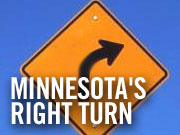|
Audio
Photos
More from MPR
Your Voice
|
A conservative sweep
August 10, 2003
 |
| David Strom says the Republican electoral victories in 2002 represent a political earthquake in Minnesota. Strom represents the Minnesota Taxpayers League, the group that sponsored Gov. Pawlenty's no-new-taxes pledge. (MPR Photo/Michael Khoo) |
St. Paul, Minn. — As a 10-year member of the Legislature -- four as House Majority Leader -- Gov. Tim Pawlenty saw plenty of political skirmishes over abortion, high school graduation standards, business liability, and handguns. He lost them all. In 2003, he won them all.
"Elections matter and ideas matter," says Pawlenty. "And that's the great thing about a democracy."
Last year's election produced a bumper crop of Republican victories. Pawlenty secured a comfortable margin over his main opponents, DFLer Roger Moe and Independence Party candidate Tim Penny. Republican Norm Coleman narrowly won a U.S. Senate battle against former Vice President Walter Mondale. John Kline defeated DFL incumbent Bill Luther in the 2nd Congressional District. And the House Republican majority's advantage swelled from eight seats to 20 -- the largest since party labels have been in use. Pawlenty says there's no mystery to the GOP's success.
"If you go down the tick-list of the top three, four, five things that most people actually vote on, rather than what the media tends to focus on,- the Republicans do better with more people," Pawlenty says.
Pawlenty lists among the more important issues: education reform, welfare reform, and transportation spending. He says Republicans have done a better job addressing those topics, turning them from traditionally DFL issues into GOP strong points.
A drift to the left
House Speaker Steve Sviggum, R-Kenyon, says it's not that Republicans in particular or Minnesotans in general have made a sudden leap to the right. He says it's the Democrats who have continued to drift left.
"I think there are a lot of people who could have identified with the Democratic agenda 30 years ago who are now just saying they've just become way too radical, they've become too extreme," says Sviggum. "And to that I can point to many, many issues. Whether it be the tax-spend issue, to the Profile of Learning, to the Women's Right to Know."
|
It was like an earthquake. The tension builds up over decades or even centuries. But, you know, you actually see the result of that tension when the earthquake happens and you get this enormous shift in the landscape. That's clearly what happened in this last election.
- David Strom |
The Women's Right to Know law may be exhibit number one in the fight to define Minnesota's political center. The law, which took effect last month, establishes a 24-hour waiting period for women seeking abortions. During that time, abortion providers are expected to provide women with state-mandated information on abortion risks and alternatives.
Minnesota Cititzens Concerned for Life spokesman John Pocock says advocates worked through 10 years and 20 committee hearings before finally passing the legislation last spring. Pocock says the debate over the Right to Know shows exactly how out of touch its opponents are.
"Oh, of course it's moderate," he says. "Almost 80 percent of Minnesota voters and more women than men, in fact, were in favor of the Minnesota Women's Right to Know law. So if you have almost 80 percent of the people supporting it, how can one side say that it's extremest in any way?"
In fact, a Minnesota Public Radio poll earlier this year found Minnesotans supported the Right to Know bill two-to-one. That leads abortion opponents to argue that if Minnesota turned right, it was only to abandon the far left for the political middle.
But supporters of legalized abortion say if Minnesotans had a better understanding of the bill, they might change their opinions. Either way, Tim Stanley says he wasn't suprised by this year's outcome. Stanley is the executive director of Minnesota NARAL, a group that advocates for access to legal abortions. He says elections have real and serious consequences.
"I went to bed on election night knowing that the 24-hour waiting period was going to pass that next winter," says Stanley. "That was going to be a fait accompli."
The impact of the legislative session
A number of other important changes can be traced to last November's election; the repeal of the Profile of Learning graduation standards, broadening the availability of handgun permits, and raising the threshold for collecting damages in certain civil cases.
Minnesota Taxpayers League legislative director David Strom says that for years pressure had been building behind those and other issues.
"It was like an earthquake," says Strom. "The tension builds up over decades or even centuries. But you actually see the result of that tension when the earthquake happens and you get this enormous shift in the landscape. That's clearly what happened in this last election."
On the wall of Strom's office hangs the no-new-taxes pledge signed by Pawlenty the candidate and honored by Pawlenty the governor. Strom says migration from rural areas to the urban and suburban Twin Cities has created a new, self-reliant, and entrepreneurial voter with a natural inclination to vote for fiscal restraint. That, he says, gave the Republicans their boost in 2002.
Will it last?
But Strom makes no predictions about the staying power of the GOP victory. Neither does Marcia Avner. Avner, the public policy director for the Minnesota Council of Non-Profits, says the budget cuts enacted this year are still filtering through the state.
"The consequences don't all happen on the first day of the fiscal year," says Avner. "We all woke up on July 1, and it was another day. Unless you happen to be a welfare recipient, unless you happen to be someone who was counting on a childcare subsidy, It was just another day."
 | |||
Avner says the governor's unwillingness to consider new taxes to erase a two-year, $4.2 billion projected deficit signaled a significant shift in state policy. If voters see their property taxes rise in response, if school activity fees increase, if cities reduce police and fire protection, Avner says the Republican trend could reverse itself.
Many key Democrats already regard the 2002 election as an anomaly. Senate Majority Leader John Hottinger, DFL-St. Peter, saw Republicans come within three votes of taking a majority in his body. But he says last year's results were clouded by the unexpected death of U.S. Sen. Paul Wellstone late in the campaign. A memorial service for the DFLer later turned controversial, further roiling the electorate. And Hottinger stresses that Pawlenty didn't win with a clear majority.
"The issues in the campaign were really around Tim Pawlenty's no-new-yaxes pledge," says Hottinger. "He didn't get 50 percent of the vote. Two, actually three, gubernatorial candidates who believed we need a more balanced approach got 54 percent of the vote."
Democrats argue that Republicans won their crushing majority in the House by striking it rich on an electoral jackpot of sorts. Republicans won 17 of the 20 toss-up races, often by razor-thin margins that Democrats say could have gone either way.
Sviggum, however, says the trend is real and with deep roots. No DFLer has won the governship since 1986. And Sviggum says the recent realignment of the legislative districts to reflect demographic trends will help Republican candidates. The old map, drawn in the early '90s by DFLers, was replaced with a court-drawn version last year.
"The lines that were drawn by the courts were a more fair representation of the citizens of the state," says Sviggum. "Where the old lines we were operating under in 1991 were probably drawn in such a way as to help the Democratic members."
In fact, some Republicans argue they were ahead of schedule when they captured the House Majority in 1998 under the old, DFL map. Having won their majority early, and having built on it since, they say, is convincing proof enough of their new strength.
|
News Headlines
|
Related Subjects
|

